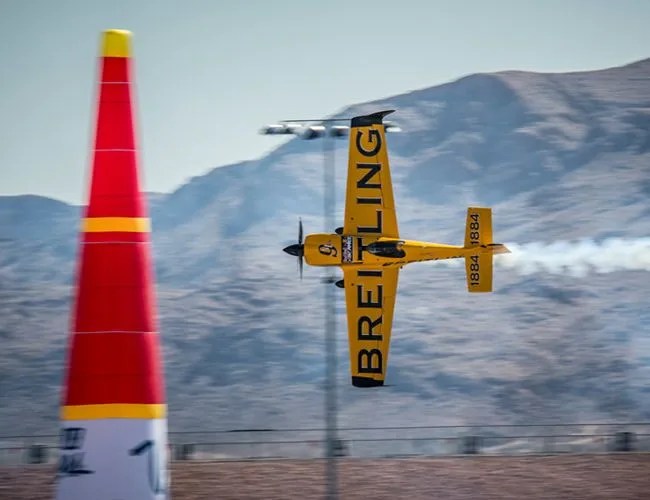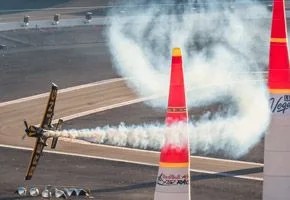Twenty-five minutes outside the Strip, set in Nevada’s stark desert, the Las Vegas Motor Speedway lacks its city’s famed opulence — but today, not its verve. A fresh energy runs throughout the massive 131,000-seat complex, though no NASCAR racers throttle up around the 1.5-mile asphalt track. Instead of staring down, everyone in the grandstands looks to the sky. The loudspeaker booms: Number 9 Lamb. You’re cleared to enter the track. Smoke on. As the plane swoops down from the sky, the crowd descends into a provocative hush. “Smoke on” is the green flag of air racing.
The Red Bull Air Race is the fastest motorsport in the world. Aerial racers snarl down upon the course at 230 mph and weave their way through a set of gates and pylons — twice. It’s solo low-flying aerobatic maneuvers in the time trial format: the ultimate challenge in speed, precision, guile and fist-sized cojones. The elite air series encompasses eight races, staged in seven countries over three continents. No two tracks are the same; each has similar features, but the layout varies. Some are over land, some over water. And with such talented pilots, every race is unique.
The Master Class competition is Red Bull Air Race’s star attraction. For twelve pilots, a split second is usually the difference between winning and not even qualifying. “The top eight or nine pilots will be separated by a single second”, explains Nigel Lamb, the 2014 Red Bull Air Race champion. Pilots get paired against one opponent, according to their qualifying times, and go head to head in a high stakes face-off. The six winners, and two fastest losers, advance into another round: the Super 8s. Another bracket generates, new races commence and eight challengers fight for four finalist spots. These survivors fly it out for the podium.
Unlike NASCAR races, where winners often credit their “great cars”, air race pilots begin each run on even air. “The regulations have changed so that the engine is standardized. The propeller is standardized. The exhaust system is standardized”, says Lamb. Even though there are four different models of planes competing (Edge 540 V2, Edge 540 V3, Corvus Racer 540, MXR-S), they all are strictly regulated to have the same power output. “The weight regulations have [also] changed so that, depending on a heavy plane-light plane or heavy pilot-light pilot, generally everyone is on the same weight. So onto the track come twelve airplanes with pretty much the same pilot-weight ratio. It’s much more about the man than the machine, and what you’ll see is an incredibly tight race.”
Pilots cover an average distance of 3.73 miles in approximately 50 seconds.
As unbelievable as it sounds for millisecond-close races through a succession of pylons at 230 mph, safety here is paramount. Since its genesis in 2005, the Red Bull Air Races have never had a serious accident. Nevertheless, the sport still took a three-year hiatus midway through 2010 to “improve safety and reorganize”. When reinstated in 2014, the Fédération Aéronautique Internationale (FAI) evened the playing field, augmenting the pylons’ height and width and laying out a fresh, extensive decorum. “It’s much safer now”, says Breitling Pilot François Le Vot. “I would guess 200 percent safer than before.”
Topping the list of new regulations are speed and g’s. Race planes are capable of hitting 275 mph, which means the 230 mph starting speed limit reins them in. Exceeding the start speed results in a second penalty, or disqualification, if they exceed 232.5 mph. G-force, contingent on speed and roll rate, is similarly capped: racers cannot exceed 10 g’s. As they fly faster with more aggressive maneuvers, the pressure exerted on the body increases. Before the rule changes, pilots were pulling upwards of 12-14 g’s, which is a comparable to finding a Ford Focus parked on your chest. Now if a pilot exceeds 10 g’s, their flight is over.

